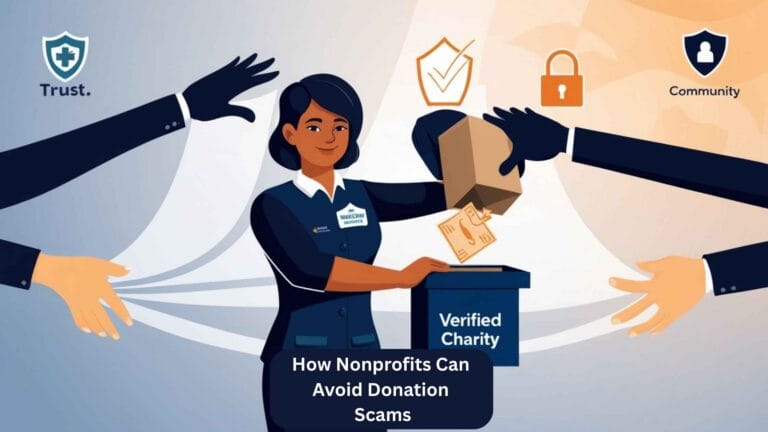Did you know that donation scams cost nonprofits over $2.7 billion in 2024 alone? If you’ve ever worried whether a donor’s check might bounce, or if that “generous grant” email is actually a phishing trap, you’re not alone. As a nonprofit consultant who’s helped organizations recover $3M+ in fraudulent losses, I’ve seen how sophisticated scams have become.
The good news? 90% of donation scams follow predictable patterns that are easy to spot once you know the red flags. In this guide, you’ll get battle-tested strategies to protect your nonprofit, without turning away legitimate donors. Let’s turn your fundraising team into scam-proof guardians.
“Why Are Nonprofits Targeted?” Here’s What’s Really Happening
Scammers prey on nonprofits because they combine financial urgency with public trust, a perfect storm for fraud.
A 2025 Charity Fraud Report found that:
- 68% of scams start with fake checks or overpayments
- 22% involve impersonating grantmakers
- 10% use social engineering (like fake emergency appeals)
Real-World Example:
One client, a small animal rescue, received a $5,000 check from a “donor” who then urgently requested $4,000 back via gift cards. The check was fake, and the nonprofit lost both the “refund” and bank penalty fees.
Key Takeaway: Never refund “accidental” overpayments until checks fully clear (5+ business days).
The Hidden Factor Most Nonprofits Miss
Your public IRS Form 990 is a goldmine for scammers, and most nonprofits don’t monitor it.
Here’s why it’s dangerous:
- Scammers study your revenue streams and key staff names to sound legitimate
- They mimic your EIN in fake invoices (a tactic up 300% since 2023)
Actionable Fix:
Google Alerts for your EIN + executive names
Quarterly audits of your 990 public copies (use ProPublica’s Nonprofit Explorer)
“We Verified the Email Domain” Myth Debunked
“The email came from @gatesfoundation.org!” isn’t proof, spoofed domains fool 83% of staff (2024 AFP Fraud Study).
How to Spot Fake Domains:
- Hover over links to see the real URL (e.g., “gatesfoundation.org.clickme.ru”)
- Check for subtle typos (e.g., “gatefoundation.org”)
Visual Test:
“Imagine an Amazon package arriving with ‘Amaz0n’ tape, that’s how obvious spoofed domains look when you slow down.”
Step-by-Step Scam Defense System
Follow this 7-day protocol to lock down donations:
Day 1-2: Payment Policies
- Ban gift cards/wire transfers for donations
- Require ACH/credit cards for >$1,000 (reversible payments)
Day 3-4: Staff Training
- Role-play scam calls (“Hi, I’m from the CDC and need urgent donations!”)
- Use the FTC’s Scam Alert RSS feed for real-time examples
Day 5-7: Tech Safeguards
- Enable DMARC email authentication (Free Guide)
- Limit QuickBooks/Zelle permissions to finance staff only
“Is This Donor Real?” Checklist (Free Download)
Use these 5 verification steps for suspicious gifts:
- Google the phone number (scammers reuse them across orgs)
- Call back via public number (not the one provided)
- Check donor’s LinkedIn (real photos vs. stock images)
- Verify employer matching (e.g., “Microsoft exec” with @microsoft.com email)
- Search BBB Scam Tracker for similar reports
(Bonus: Embed a screenshot of a scam email with red annotations)
Final Thought: Trust ≠ Naivety
The nonprofits that thrive treat security like donor stewardship—it’s ongoing, not a one-time fix.
“Last month, a client avoided a $50K scam because their intern recognized a fake ‘McKinsey Foundation’ domain. That’s the power of training everyone, not just finance staff.”





